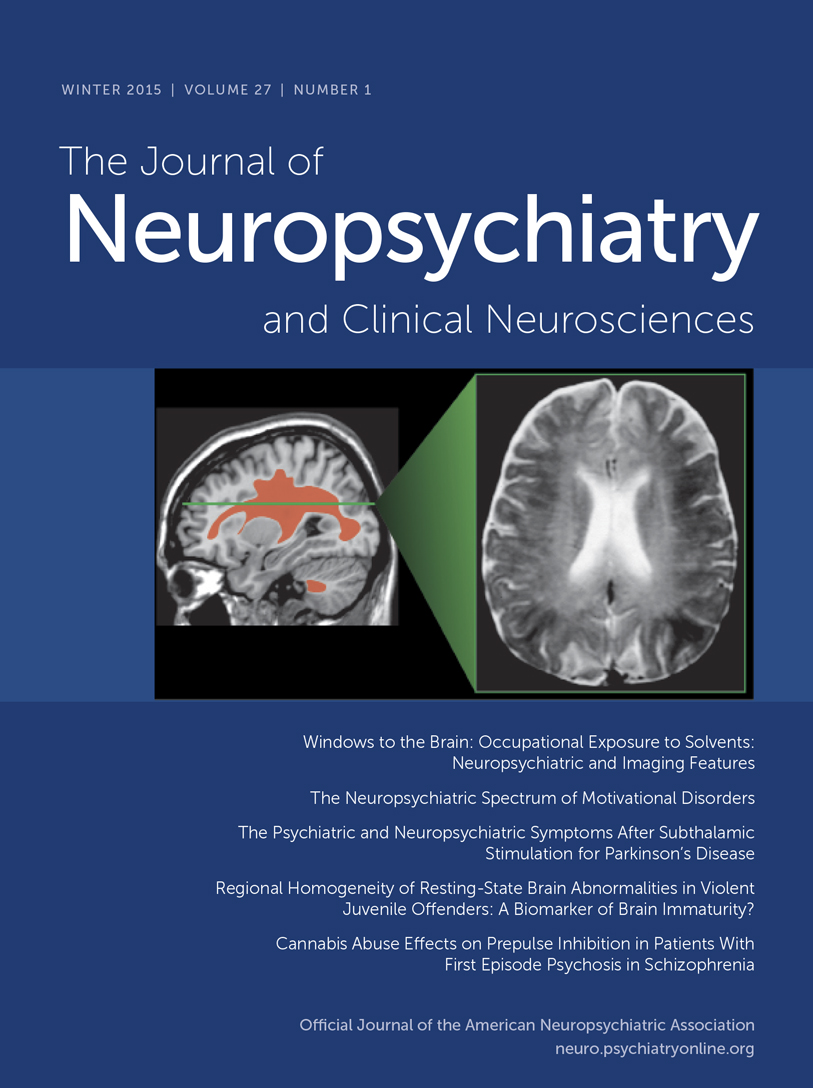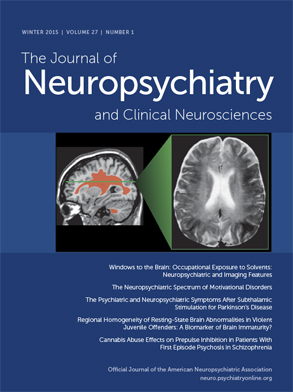The
N-methyl-
d-aspartic acid (NMDA) receptor antagonist memantine (Ebixa; Lundbeck Canada, Montreal, Canada) has demonstrated efficacy against the development of agitation and aggressiveness in Alzheimer’s disease (AD),
1–3 hypothetically via correction of glutamate transmission and reduction of tangle formation in the frontal and cingulate cortices.
4,5 Conversely, memantine has been shown to cause agitation and other psychotic manifestations. A total of 11 cases of AD,
6,7 Lewy body disease,
8–10 and Parkinson’s disease
11 have been reported who developed agitation, hallucinations, delusions, and intense dreaming after a few doses and recovered at drug withdrawal. This apparently paradoxical effect of memantine has a neurochemical plausibility. The NMDA hypofunction within the limbic system is deemed to underlie psychotic disorders,
5 and psychotic symptoms are a known side effect of other glutamate receptor antagonists such as amantadine and phencyclidine.
In the present study, we retrospectively reviewed the clinical records of a large sample of patients with dementia treated with memantine, with the aim to measure the prevalence of treatment-emergent agitation in naturalistic conditions and identify possible clinical correlates of this puzzling effect of the drug.
Patients and Methods
Participants were enrolled from the memory clinic of S. Gerardo Hospital, Monza, Italy. They were consecutive patients started on memantine between January 2008 and December 2010 and followed up for at least 6 months since therapy onset. Criterion for inclusion was a diagnosis of dementia according to DSM IV criteria.
12 The study had the relevant institutional ethical approval and complied with the Declaration of Helsinki.
As prescribed in the drug instruction sheet, the maximum daily dose of 20 mg was usually achieved by upward titration of 5 mg/week over a period of 3 weeks.
Agitation, restlessness, irritability, and aggressiveness reported by patients or informants were all recorded as agitation; co-occurrence of confusion, hallucinations, and delusions was also taken into account. The symptoms were deemed to be drug related when they developed de novo or worsened if already present at study entry, in temporal relationship with treatment start or increase, and resolved after dose reduction or withdrawal.
The following characteristics of patients with (A+) and without (A−) memantine-related agitation were compared using two-tailed Student’s t or chi-square tests: percentage of AD and non-AD diagnoses; Mini Mental State Examination (MMSE) score; presence of neuropsychiatric disturbances at treatment onset; previous episodes of agitation caused by other drugs; type and frequency of comorbidities; distribution of concurrent medications; evidence of chronic small vessel disease at the visual rating of brain CT or MRI scans by the neuroradiologist. The level of significance was set at p<0.05, and Bonferroni correction for multiple comparisons was applied. Statistical analysis was performed with PASW statistics, Release Version 18.0.0 (SPSS, Chicago, IL).
Results
A total of 209 cases meeting inclusion criteria were identified, but 13 had to be excluded due to inadequate data. Of the 196 cases included in the final sample, 11 (5.6%) showed memantine-related agitation, and their demographic and clinical features are shown in
Table 1.
The remaining 185 patients were 70 men (38%) and 115 women, with a mean age of 77.3±8.0 years and a mean MMSE score of 16.9±5.0 and had the following diagnoses, based on current criteria
13–18: AD (n=113, 61%), vascular or mixed dementia (n=21, 11%), Lewy body dementia (n=16, 9%), fronto-temporal dementia (n=13, 7%), corticobasal degeneration (n=8, 4%), nonotherwise specified dementia (n=8, 4%), and posterior cortical atrophy (n=6, 3%). Within this A− group, 148 patients (80%) showed mild (n=71, 38%) or moderate to severe (n=77, 42%) behavioral disturbances at the time they were started on memantine. After 2.1±1.1 years of treatment on average, an improvement of agitation was reported by the clinician, based on informants’ reports, for 28 cases (19%).
A brief description of the adverse events with memantine is reported in
Table 1. In five of 11 (45.5%) patients, agitation developed de novo, whereas in the other six patients, it was preexisting and worsened after drug introduction. In four cases (36.4%), it was associated with confusion, and in one patient (9.1%), it was associated with de novo visual hallucinations. The adverse effects became evident after the first doses in seven cases (63.6%) and when the daily dose was increased to 10 mg or above in the other four patients. Memantine was reduced to 10 mg/day in two cases (18.2%) and was withdrawn in all the others, with a complete remission of the adverse effects within a few days. No A+ patient completed more than 2 weeks at 20 mg. In case 7, the drug was tentatively reintroduced 18 months later, with a slower increase to 20 mg, but again had to be discontinued due to agitation and confusion.
Within the study follow-up period (2.2±1.0 years on average), a total of 22 adverse effects tentatively attributed to memantine were also observed in the A− group, the most frequent (3.6%) being a vague feeling of “being unwell” (
Table 2). Because of these side effects, treatment was withdrawn or reduced in 20 (10.2%) cases. Discontinuation also occurred in 45 (23%) other A− patients for reasons other than adverse events, e.g., disease progression (
Table 3). The mean duration of treatment was 2.0±1.2 years for the A− group (range: 1 month to 5.3 years).
Results of comparison analysis for demographic and clinical features of A+ and A− patients are shown in
Table 3. After Bonferroni correction, a statistically significant difference (p=0.001) was found for a greater frequency, in the A+ group, of past episodes of agitation in response to other drugs (rivastigmine in one patient, donepezil in another case, donepezil and citicoline in a third patient, and piracetam in one last case). A strong trend toward significance was present for a higher prevalence of brain small vessel disease and ischemic cardiopathy (36.4% versus 6.5%, p=0.007, for both), whereas no difference emerged in the distribution of related medications. There was no case of overlap of the three more significant variables in the A+ group; only one of four patients with cerebrovascular disease also showed ischemic cardiopathy, and only two of four patients taking anticholinesterase inhibitors also showed one of the two disorders. This suggests an independent contribution for the three features.
The 28 cases who showed improvement in behavioral disturbances after starting memantine did not differ from the A+ group for the following features: age, gender, education, distribution of diagnoses, disease duration, MMSE score, percentage of patients treated with anticholinesterase inhibitors or other neuropsychiatric drugs, and prevalence of non-neurological comorbidities or treatments (data not shown). A trend toward significance was only present for a higher proportion of A+ cases showing brain small vessel disease at neuroimaging (36.4% versus 7.1%, p=0.042).
Discussion
The retrospective nature of our study and the lack of structured measures of safety (e.g., a neuropsychiatric scale) did not allow a systematic, fine-grained, and standardized collection of data. Moreover, being unblinded to treatment, we may have been biased in establishing a causal relationship between memantine and agitation. Also, the absolute number of cases showing the adverse effects was small and allowed only an exploratory analysis of features comparisons. Finally, errors in the presumed clinical diagnoses cannot be ruled out, and might have affected our results because the underlying pathological diagnosis may be a risk factor for the development of memantine-induced agitation.
On the other hand, the entire study population was relatively large and was studied in a naturalistic setting, which guarantees a realistic and clinically relevant depiction of the event under investigation. Therefore, we believe that useful indications for future studies may come from our results, along with some hint for clinical practice.
In particular, we highlighted some feature that may help dementia specialists to identify patients at risk of developing neuropsychiatric side effects of memantine. A red flag seems to be a history of agitation in reaction to brain enhancers. Informants should be specifically inquired about that before treatment start. Evidence of chronic microvascular changes at neuroimaging and presence of coronary heart disease (more precisely, a history and/or electrocardiographic or echocardiographic evidence of miocardial infarction) should also be taken into account, whereas preexisting agitation and concomitant medications do not necessarily entail a more careful monitoring of the patient once he/she is started on memantine.
The fact that A+ patients showed the same side effects in response to other medications acting on the central nervous system suggests that some subject might have a neurochemical predisposition to develop the adverse event. Following the glutamate model of psychosis,
5 it could be hypothesized that a low baseline glutamatergic tone might make them more vulnerable to the psychosis-inducing effect of the NMDA antagonist. Cerebrovascular damage and ischemic cardiopathy are known to cause anatomical and functional changes in the brain.
19 Such changes might also decrease NMDA transmission. Finding a biochemical account for memantine-related agitation is anyway beyond the scope and possibilities of our work and will have to be addressed in future studies.
Upcoming investigations should also explore clinical differences between patients with the adverse event and those with the opposite effect, i.e., with a positive impact of memantine on the development of agitation. In the present study, we could only explore the prevalence (6%) of improvement in preexisting agitation informally, in unblinded conditions, and without controlling for the contribution of concomitant neuropsychiatric drugs. In clinical trials,
1,2 agitation is reported in 7%−8% of patients treated with memantine. According to our results, only a minority of these cases can be classified as nonresponders who do not benefit from the preventive effect of the drug on behavioral disturbances. Most of them are actually experiencing an adverse event, which, being disturbing and reversible with drug withdrawal, imposes therapy discontinuation. Given the limited options of treatment available for patients with dementia, the impact of this phenomenon on their prognosis and management can be very heavy.

